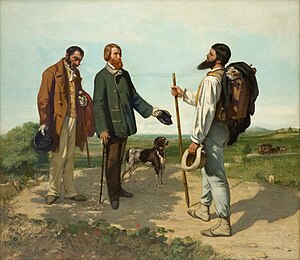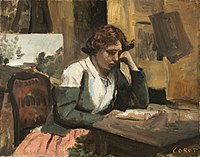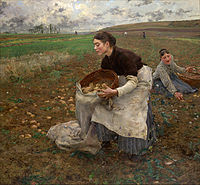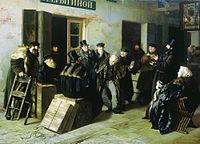Realism Was a Late19th Century Counterreaction to Idealized Art of Romanticism

Realism was an artistic move that emerged in France in the 1840s, effectually the 1848 Revolution.[one] Realists rejected Romanticism, which had dominated French literature and fine art since the early 19th century. Realism revolted against the exotic subject thing and the exaggerated emotionalism and drama of the Romantic movement. Instead, it sought to portray real and typical gimmicky people and situations with truth and accuracy, and non avoiding unpleasant or sordid aspects of life. The movement aimed to focus on unidealized subjects and events that were previously rejected in art work. Realist works depicted people of all classes in situations that arise in ordinary life, and often reflected the changes brought by the Industrial and Commercial Revolutions. Realism was primarily concerned with how things appeared to the eye, rather than containing ideal representations of the world.[ commendation needed ] The popularity of such "realistic" works grew with the introduction of photography—a new visual source that created a desire for people to produce representations which expect objectively real.
The Realists depicted everyday subjects and situations in contemporary settings, and attempted to draw individuals of all social classes in a like manner. Gloomy earth toned palettes were used to ignore beauty and idealization that was typically institute in art. This movement sparked controversy because it purposefully criticized social values and the upper classes, likewise as examining the new values that came forth with the industrial revolution. Realism is widely regarded as the outset of the mod art motility due to the push to contain modern life and art together.[two] Classical idealism and Romantic emotionalism and drama were avoided every bit, and frequently sordid or untidy elements of subjects were not smoothed over or omitted. Social realism emphasizes the delineation of the working class, and treating them with the same seriousness every bit other classes in art, but realism, equally the abstention of artificiality, in the treatment of human relations and emotions was likewise an aim of Realism. Treatments of subjects in a heroic or sentimental manner were equally rejected.[3]
Realism as an art movement was led by Gustave Courbet in France. Information technology spread beyond Europe and was influential for the rest of the century and beyond, but as it became adopted into the mainstream of painting it becomes less common and useful equally a term to define artistic mode. Afterwards the inflow of Impressionism and later movements which downgraded the importance of precise illusionistic brushwork, it often came to refer simply to the use of a more than traditional and tighter painting style. Information technology has been used for a number of later movements and trends in fine art, some involving conscientious illusionistic representation, such as Photorealism, and others the depiction of "realist" subject field thing in a social sense, or attempts at both.
Beginnings in France [edit]

The Realist movement began in the mid-19th century as a reaction to Romanticism and History painting. In favor of depictions of 'real' life, the Realist painters used mutual laborers, and ordinary people in ordinary environment engaged in existent activities as subjects for their works. The primary exponents of Realism were Gustave Courbet, Jean-François Millet, Honoré Daumier, and Jean-Baptiste-Camille Corot.[4] [5] [6] Jules Bastien-Lepage is closely associated with the beginning of Naturalism, an creative style that emerged from the afterward phase of the Realist movement and heralded the arrival of Impressionism.[7]
Realists used unprettified particular depicting the existence of ordinary contemporary life, congruent in the contemporaneous naturalist literature of Émile Zola, Honoré de Balzac, and Gustave Flaubert.[8]
Courbet was the leading proponent of Realism and he challenged the popular history painting that was favored at the land-sponsored art university. His groundbreaking paintings A Burial at Ornans and The Stonebreakers depicted ordinary people from his native region. Both paintings were done on huge canvases that would typically be used for history paintings.[viii] Although Courbet'southward early works emulated the sophisticated fashion of Onetime Masters such as Rembrandt and Titian, afterwards 1848 he adopted a boldly inelegant style inspired past popular prints, shop signs, and other work of folk artisans.[9] In The Stonebreakers, his first painting to create a controversy, Courbet eschewed the pastoral tradition of representing human subjects in harmony with nature. Rather, he depicted two men juxtaposed confronting a charmless, stony roadside. The concealment of their faces emphasizes the dehumanizing nature of their monotonous, repetitive labor.[9]
Beyond French republic [edit]

The French Realist motility had stylistic and ideological equivalents in all other Western countries, developing somewhat afterward. The Realist movement in France was characterized by a spirit of rebellion confronting powerful official support for history painting. In countries where institutional support of history painting was less dominant, the transition from existing traditions of genre painting to Realism presented no such schism.[9] An important Realist movement across France was the Peredvizhniki or Wanderers group in Russia who formed in the 1860s and organized exhibitions from 1871 included many realists such as genre creative person Vasily Perov, landscape artists Ivan Shishkin, Alexei Savrasov, and Arkhip Kuindzhi, portraitist Ivan Kramskoy, state of war artist Vasily Vereshchagin, historical artist Vasily Surikov and, particularly, Ilya Repin, who is considered by many to be the near renowned Russian artist of the 19th century.[11]
Courbet's influence was felt most strongly in Germany, where prominent realists included Adolph Menzel, Wilhelm Leibl, Wilhelm Trübner, and Max Liebermann. Leibl and several other young German painters met Courbet in 1869 when he visited Munich to showroom his works and demonstrate his manner of painting from nature.[12] In Italy the artists of the Macchiaioli grouping painted Realist scenes of rural and urban life. The Hague Schoolhouse were Realists in the Netherlands whose style and field of study affair strongly influenced the early on works of Vincent van Gogh.[9] In Britain artists such as the American James Abbott McNeill Whistler, likewise equally English artists Ford Madox Brown, Hubert von Herkomer and Luke Fildes had great success with realist paintings dealing with social issues and depictions of the "real" world.
In the United States, Winslow Homer and Thomas Eakins were important Realists and forerunners of the Ashcan School, an early-20th-century art movement largely based in New York City. The Ashcan School included such artists as George Bellows and Robert Henri, and helped to ascertain American realism in its trend to describe the daily life of poorer members of lodge.
Subsequently on in America, the term realism took on various new definitions and adaptations once the motion hitting the U.S. Surrealism and magical realism developed out of the French realist motility in the 1930s, and in the 1950s new realism developed. This sub-movement considered art to exist as a matter in itself opposed to representations of the existent world. In mod-twenty-four hours America, realism art is generally regarded as annihilation that does not fall into abstract art, therefore including mostly art that depicts realities.[ citation needed ]
References [edit]
- ^ Metropolitan Museum of Art
- ^ "Realism Movement Overview". The Fine art Story . Retrieved 2019-02-25 .
- ^ Finocchio, Ross. "Nineteenth-Century French Realism". In Heilbrunn Timeline of Fine art History. New York: The Metropolitan Museum of Art, 2000–. online (October 2004)
- ^ NGA Realism movement Archived 2014-07-xiv at the Wayback Machine
- ^ National Gallery glossary, Realism motility
- ^ Philosophy of Realism
- ^ Fry, Roger. 1920. "Vision and Design." London: Chatto & Windus. "An Essay in Æsthetics." 11-24. Accessed online on xiii March 2012 at "Archived copy". Archived from the original on 2013-xi-xiv. Retrieved 2017-09-09 .
{{cite web}}: CS1 maint: archived copy equally title (link) - ^ a b Nineteenth-Century French Realism | Essay | Heilbrunn Timeline of Art History | The Metropolitan Museum of Art
- ^ a b c d Rubin, J. 2003. "Realism". Grove Fine art Online.
- ^ National Gallery of Art
- ^ "10 Most Famous Russian Artists And Their Masterpieces | Learnodo Newtonic". Retrieved 2021-ten-fourteen .
- ^ Nationalgalerie (Berlin), and Françoise Forster-Hahn. 2001. Spirit of an Age: Nineteenth-Century Paintings From the Nationalgalerie, Berlin. London: National Gallery Visitor. p. 155. ISBN 1857099605
External links [edit]
- 19th Century French Realism, Heilbrunn Timeline of Art History, Metropolitan Museum of Fine art
| | Wikimedia Eatables has media related to Realism. |
cockburn-campbellforgand.blogspot.com
Source: https://en.wikipedia.org/wiki/Realism_%28art_movement%29











